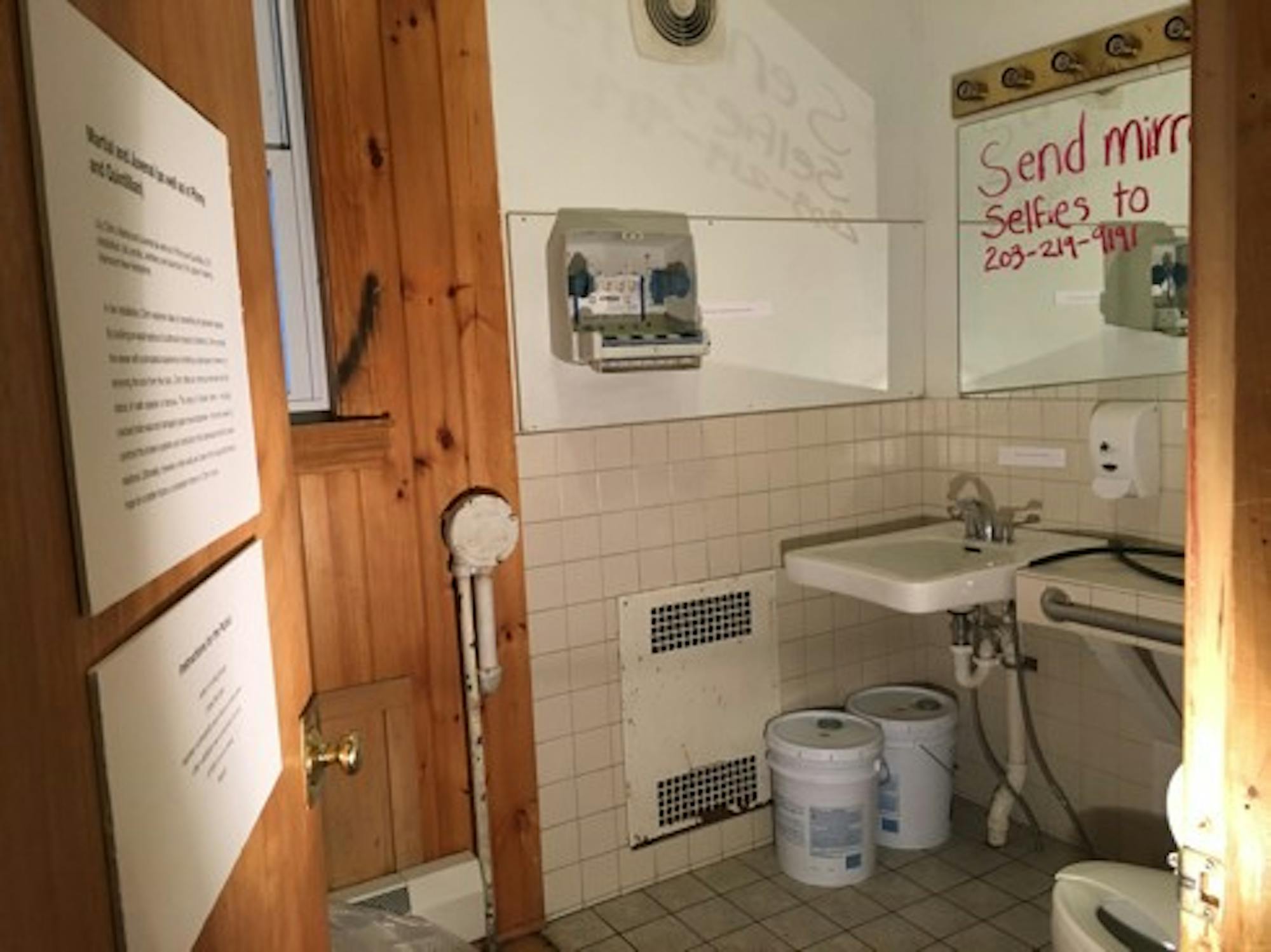For Lily Citrin ’17, the impulsive need to create has marked her artistic process since childhood. When Citrin was in the fourth grade, she told a teacher that she was going to write a book and received a patronizing reply. This dismissal motivated her to write her first novel — 80 pages long.
Citrin said that her journey as an artist is rooted in her arrival and time at Dartmouth, but that she actively strove to be creative during high school.
In her junior year, she recorded videos of her friends. One particularly struck a chord with her — a “ridiculous” argument between friends over a boy, due to their false perception of low self-worth. Citrin transformed the audio of this fight into an upcoming video installation called “A puppeteer may or may not be visible.” Citrin removed any visual markers tying the piece in reality, choosing to pair the audio with slowed-down video footage of a moving piece of shiny metal foil.
A motif that spans Citrin’s work is the bathroom. In March, Citrin put up an installation at the Psi Upsilon fraternity house. The bathroom itself was her installation, titled “Martial and Juvenal (as well as in Plinny and Quintillian).” In the tradition of galleries and museums, Citrin put wall text on the inside of the door of the bathroom, writing in third person about her own work, and included instructions on how to “experience” the installation. Citrin intended for her art to be taken seriously and even threw an official opening for the installation, complete with wine and cheese.
“[Citrin] builds off of initially playful ideas that grab your attention by their absurdity or unexpectedness,” said Marina Massidda ’17, a studio art major and friend of Citrin’s. “Yet as you spend time with the work, it also provokes a deeper conversation.”
The bathroom was a safe space within the male-dominated space of the fraternity house, Citrin said, where women sought validation and support from each other. The installation was also a living installation: The mirror was marked with Citrin’s cell phone number, soliciting mirror selfies of people who used the bathroom. She curated these submissions and arranged them into an additional printed piece.
“[Citrin’s] work speaks to the very subtle ways in which young women in particular are using photography, social media and modern technology to create relationships,” said Hannah Nelson, a photography fellow with the studio art department.
Citrin’s final remnant of that work, the print, harkens back to artists prompting audiences to contemplate authorship, like photographer Doug Rickard in his Google-Earth inspired photo series.
Nelson, who has worked closely with Citrin, said that the nature of photography has changed.
“The artist no longer has to be the author of the photograph,” Nelson said. “[Citrin] is running with that; the photographs are just a vehicle for the viewer’s interactions with the space, each other and the work itself.”
The bathroom was not Citrin’s first foray into living installations and art. When the third floor of Berry Library was being renovated, blue plastic draped the walls and covered the floors. Citrin thought that it was artistic and presented this as a readymade, much like Marcel Duchamp’s “Fountain.” The underlying principle was that found objects can take on aesthetic and artistic qualities when considered to be art by an artist.
Titled “Construction,” Citrin inaugurated the exhibit with her friends, declaring it open and living. Her art is a mediation between the tangible and the conceptual, and that is what makes it unique.
For her studio art exhibition this year, she chose to construct a bathroom, titled “Sanctuary.” Hung from the roof, the shower curtains drape themselves across the airy and open space that she created. The stool in the bathroom, too, is measured to the exact height of the average pot, Citrin said. A roll of toilet paper is a means for people who “experience” the installation to write down their thoughts and put it in the trash can, remnants which other people can later pick up and read. At first sight, the installation looked like a brand-new, enclosed version of Eva Hesse’s “Contingent.” Citrin’s style is the reconciliation of the conceptualism and Dadaism that Duchamp championed and the post-minimalism of Hesse.
A double major in studio art and history modified with storytelling, an interdisciplinary modification created by Citrin that includes courses in playwriting, screenwriting and creative writing, Citrin’s academic career at Dartmouth is far from conventional. The construction of narratives is important to the way that Citrin approaches her art, and she emphasizes this when she talks about her work. For Citrin, history is just another story, and she weaves this into her creative process.
“The Black Family Visual Arts Center is where I take refuge from Dartmouth,” Citrin said. “It is my escape, and I spend long hours here.”
On her frequent trips to dollar stores, she sifts through vast lots of items to figure out what she would like to work with, Citrin said. Her inspiration is from the mundane, but her art transforms these objects into something meaningful and introspective, prompting the viewer to ask questions. Citrin is no radical, but she is part of an important avant-garde in contemporary art, placing focus on the human condition and the experience of the creation of art itself.
Correction Appended (May 24, 2017):
A previous version of this article referred to Citrin as a studio art minor, when she is, in fact, a studio art major. The title of her installation "A puppeteer may or may not be visible" was also incorrectly called "Atmospheric Tinsel." The article has been updated to reflect these changes.




